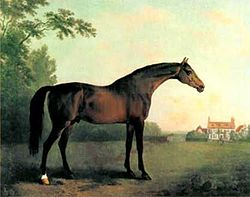Highflyer (horse)
| Highflyer | |
|---|---|
 |
|
| Sire | Herod |
| Grandsire | Tartar |
| Dam | Rachel |
| Damsire | Blank |
| Sex | Stallion |
| Foaled | 1774 |
| Country | Great Britain |
| Colour | Bay |
| Breeder | Sir Charles Bunbury, 5th Baronet |
| Owner | Frederick St John, 2nd Viscount Bolingbroke ("Mr. Compton"), Richard Tattersall |
| Record | 14: 14-0-0 |
| Major wins | |
|
1400 Guineas Stakes (1778) Great Subscription Purse (1779) Great Subscription Purse (1779) |
|
| Awards | |
| Leading sire in Great Britain & Ireland (1785-1796, 1798) | |
| Last updated on 13 January 2011 | |
Highflyer (1774 – 18 October 1793) was an undefeated Thoroughbred racehorse and a very successful and influential sire of the 18th century.
Bred by Sir Charles Bunbury, the fifth Baronet, the colt was foaled at Great Barton, in 1774. Highflyer's sire was the important Herod, one of the foundation stallions for the classic Thoroughbred, and himself an excellent racehorse and stud, producing Florizel (b.c. 1768) and Woodpecker (ch.c. 1773). His dam, Rachel (1763) was by Blank, and out of a mare by Regulus, both stallions by the Godolphin Arabian, making Rachel inbred 2x3 to the great stallion. Blank also sired Pacolet (1763). Highflyer was a half-brother to Mark Anthony (b c 1767 Spectator) who sired the Epsom Derby winner Aimwell.
Highflyer was a bay stallion with a sock on a hind pastern. The Arabian influence could still be seen in him, having a light overall build, with a small, refined, slightly dished head, an arched neck, short back, relatively flat croup, and high-set tail. His abilities on the track could have been foreseen in his very muscular hindquarters, sloping shoulder, and deep barrel.
Highflyer began his racing career at a time when the trend was shifting from starting Thoroughbreds at the track at age five, to instead begin racing them at a younger age. His maiden race was in October, in a two-mile event for three-year-olds at Newmarket, which he won. He returned to Newmarket the following year, beating out the four-year-olds in both the July and October meet, before winning an open stakes, as well as a match against the Matchem son, Dictator.
In 1779, he won an additional two races before Lord Bolingbroke accepted an offer from Richard Tattersall, who bought the colt for 2,500 pounds. Highflyer continued to race, winning with a walk over at Nottingham and in York at the Great Subscription Stakes. He then won the Great Subscription Stakes for a second time, before winning the King's Purse at Lichfield. He finished his racing career undefeated in 14 race starts.
Tattersall's grand plan for Highflyer was built to make him rich, and it certainly accomplished its task. It rested on two main points. First, Tattersall would breed Highflyer to as many mares as possible, bringing in income from the stud fee (a practice for which he was criticised, as many thought he was over-breeding the animal and later pointed to Highflyer's death at 19 to be proof of that fact). To help accomplish this, he stood his stallion at his Red Barns farm for the initial fee of 15 guineas, eventually raising the fee to 50 guineas. His second tactic was to buy up as many daughters of Eclipse as he could, breed them to breed Highflyer, and sell them on in-foal. This combined the blood of Herod and Eclipse to produce some excellent racehorses who would form the basis of the modern Thoroughbred. Estimates have found that Tattersall made at least 15,000 pounds each year off of Highflyer breedings, from which he build a mansion at aptly named it Highflyer Hall.
...
Wikipedia
